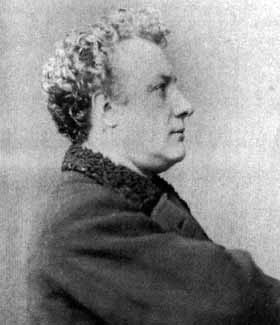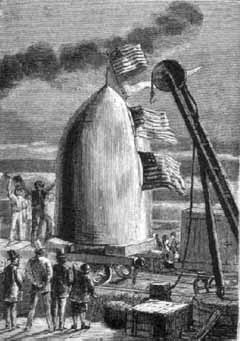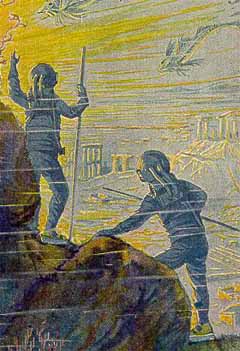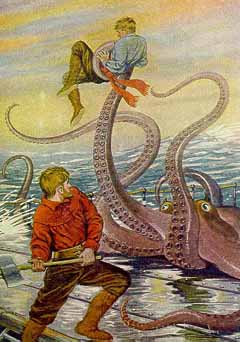|

Jules
Verne
|
Jules
Verne: An Author Before His Time?
This 19th century author's novels predicted
submarines, flying machines, skyscrapers and even the moon landing
while at the same time inspiring some of the world's most important
scientists. How did he do it?
On the 31st of January, 1863, a small volume began
appearing in bookstores all over France. It was the adventure
of three travelers, led by a Dr. Fergusson, who dared to penetrate
the interior of darkest Africa using a balloon. The brave explorers
in the story risk angry, spear-carrying natives, ferocious baboons,
and slow death by dehydration during their trip. Readers found
themselves puzzled by this account. Was it fact or fiction?
It read like an authentic travel diary, including detailed descriptions
of natural phenomena that was seen and notes taken on the longitude
and latitudes as the travelers moved, but the adventures seemed
fantastic!
In the Paris daily Le Figaro a review read,
"Is Dr. Fergusson's journey a reality or is it not? All
we can say is that it is bewitching as a novel and as instructive
as a book of science. Never have the serious discoveries of
celebrated travelers been summed up as well."
The title of this amazing work was Five Weeks
in a Balloon and its first-time author was a man named Jules
Verne.
Early
Life
Jules Verne was born on February 8, 1828, in the
city of Nantes, France. His father, Pierre Verne, was a lawyer.
From the family's summer house just outside the city, young
Jules could look out and see the great docks and shipbuilding
facilities of the region. Jules prided himself at having grown
up "in the center of maritime life of a great commercial
city, port of call of innumerable long voyages." He watched
the great clipper ships and three masted schooners come and
go as he used his imagination to climb their masts and ride
the great vessels to foreign ports of call.
For payment of a franc Jules and his younger brother
Paul would rent a boat for the day and go sailing behind their
summer house. It was during one of these times that Jules found
himself stranded about 30 miles downstream when a plank came
lose and the boat sunk. Stuck on a small islet, he was forced
to wait until low tide to wade across to the mainland and walk
home. The incident was embellished by an early biographer into
an attempt by the young Verne to sail off across the Atlantic
as a cabin boy on a ship headed for the West Indies, only to
be rescued by his father at the last moment. The tale, while
a favorite with Verne fans, shows not the slightest sign of
being true.
Verne's father, wishing to see his son follow
in his footsteps, sent him to Paris to study law. While there
he found himself attracted to the theater. Encouraged by his
friend, the elder Alexandre Dumas (author of The Three Musketeers),
Verne tried his hand at writing plays. The first one was produced
in 1850. Over the next ten years Verne tried to make a living
as a playwright. He gave up the law (to the great alarm of his
father) to create a series of not terribly successful works
for the stage including The Companions of the Marjolaine
and Blindman's Bluff. In order to support himself Verne
became a stockbroker, a career that did not capture his heart,
but gave him enough financial stability to marry a widow named
Honorine in 1857. In 1861 their only child was born, Michel
Jean Pierre Verne.
Novelist
It was the year 1862 in which Verne's career took
off in a new direction. There is legend that he stood on the
steps of the Paris stock exchange and declared to his associates
there, "My boys, I believe that I'm about to desert you.
I had the kind of idea Emile Girardin says every man must have
to make a fortune. I've just written a new kind of novel, and
if it succeeds it will be an unexplored gold mine. In that case
I'll write more such books while you're buying your stock. And
I think I'll earn the most money!" When his friends laughed
at his comments, he replied, "Laugh, friends, we'll see
who laughs longest."
|

Early
illustration of Verne's manned projectile from the book
From the Earth to the Moon.
|
It is hard to say if the above story is true.
However, Verne certainly did invent a new kind of novel, and
it did bring him fortune and fame.
When he set out to write Five Weeks in a Balloon
Verne had no knowledge of ballooning, nor had he ever been to
Africa. He probably drew heavily on the writings of others including
Edgar Allan Poe's The Balloon Hoax, a story about a group
of Englishmen who accidentally cross the Atlantic in a balloon,
and Poe's The Unparalleled Adventures of One Hans Pfaall,
a tale about a trip to the moon in a balloon.
To make his accounts of Africa realistic Verne
undoubtedly relied on magazines such as Louis Hachette's Le
Tour du Monde-Nouveau Journal des Voyages. This weekly publication
contained articles on explorations around the world and included
maps, illustrations of ships, and descriptions of customs in
remote locations. These details would have certainly been invaluable
to Verne in fleshing out his novel.
The
Publisher
Every writer needs a publisher, and Verne's was
a man by the name of Pierre-Jules Hetzel. Hetzel and Verne were
introduced to each other in 1862 by a mutual friend, writer
Alfred de Brehat. Shortly afterward they entered into a partnership
that would last most of their lives. In Hetzel, Verne had found
the ideal publisher, and in Verne, Hetzel had found the ideal
writer. Hetzel's careful editing and insightful suggestions
for changes to Verne's manuscripts perhaps made Hetzel nearly
as responsible for their success as was Verne himself. Together
they would turn out one lucrative novel after another.
Hetzel also introduced Verne to Felix Nadar, a
renaissance man with interests in aerial navigation and ballooning.
Though it is impossible to say if Nadar contributed any ideas
to Five Weeks in A Balloon, we do know that Nadar, in
turn, introduced Verne to his circle of scientific friends.
Conversation among them undoubtedly guided Verne while writing
his early scientific stories. Later when Nadar founded the Society
for Encouragement of Aerial Locomotion by Means of Heavier-Than-Air
Craft, Verne was listed as a member of the board.
Though many people think of Verne as a scientist
or a world traveler, in truth he was neither. Much of his research
for his works was done through reading books and periodicals
or discussing the scientific breakthroughs of the day with his
knowledgeable friends. We are often amazed when his scientific
predictions in his books turn out right, but the truth is we
more easily forget the ones that are wrong.
Verne realized that he had finally found his place
in the world and threw himself into his work with great enthusiasm.
In a progress report to Hetzel while working on a novel about
exploring the North Pole he wrote, "I'm in the middle of
my subject at 80 degrees latitude and 40 degrees centigrade
below zero. I'm catching cold just writing about it!" In
the next ten years he was to create many of his classic novels
for which he is best remembered.
Even before the first copies of Five Weeks
in a Balloon went on sale, Verne was hard at work on this
next adventure: The tale of a tenacious explorer named Captain
Hatteras and his difficult journey to reach the North Pole.
Hatteras's odyssey was published as two books, The English
at the North Pole and The Wilderness of Ice, but
before these were released Verne was already starting on a book
that is still widely read today, Journey to the Center of
the Earth.
Even in these early books it is easy to see that
Verne was fascinated in building a closed universe in which
his characters could act. In some cases it was a balloon basket,
in others an island, cave or a ship. Almost always Verne's heroes
are characters that can thrive in that universe, making do with
whatever available materials there are to build a solution to
the obstacles that arise.
Paris
in the 20th Century
Though today we think of Verne as an optimist
and an unswerving supporter of scientific progress, this was
not really the case. Early on he had doubts about the effects
of too much technology on human lives. In 1863 he penned Paris
in the 20th Century, a novel about a young man living in
a future world with skyscrapers of glass and steel, high-speed
trains, gas-powered automobiles, calculators, and a worldwide
communications network. The hero cannot find happiness in this
highly materialistic environment, however, and comes to a tragic
end.
Verne took this novel to Hetzel, who declined
to publish it. Hetzel, knowing the mood of the times, thought
that the novel would not be successful and might even damage
Verne's career. "Wait twenty years to write this book,"
Hetzel wrote in the margins. "Nobody today will believe
your prophecy, nobody will care about it." Verne followed
Hetzel's advice and the manuscript was dropped into a safe where
it lay until 1989 when it was discovered by Verne's great-grandson.
It wasn't until Hetzel's death in 1886 that a more pessimistic
side of Verne reemerged in his literature.
From the Earth to the Moon (1865) was Verne's
next major novel and the resemblance to the actual Apollo program
is uncanny. Following the civil war a group of gun enthusiasts
decides to fire a cannonball to the moon. At first the flight
is to be unmanned, but then the French daredevil Michel Ardan
(an anagram for Verne's friend Nader) volunteers to ride in
it. To test the idea of manned flight they launch a cat and
a squirrel (NASA would later use monkeys) and recover them at
sea. Two Americans join Ardan and the three of them (the same
number of astronauts as the Apollo program used) are launched
from an enormous cannon located in Florida just a few miles
from where the Kennedy Space Center would eventually sit. When
they return, they splash down in the Pacific, another similarity
to the first real moon shots. The book ends with the successful
launch of the 19th century astronauts. Readers would have to
wait four years until the sequel was published to find out what
happened to the intrepid adventurers.
In 1867, Verne, accompanied by his brother Paul,
made his single trip to North America crossing on the huge steamship,
the Great Eastern. Ironically, as much as Verne was fascinated
by the United States and the American people, he only stayed
a week. In that short amount of time he was able to cram in
a visit up the Hudson River to Albany, then on to Niagara Falls.
The short trip would remain locked in Verne's memory, with portions
of his experiences appearing in several of his later works.
20,000
Leagues Under the Sea
|

Nemo
and Aronnax explore Atlantis in this early 20th century
illustration.
|
His idea for his next major novel, 20,000 Leagues
Under the Sea, was perhaps sparked by a note from fellow
Hetzel author George Sand in 1865. After reading several of
Verne's novels, she wrote "...I have only one regret concerning
these stories, which is to have finished them and not to have
a dozen more to read...I hope that you will soon take us to
the depths of the sea and have your characters navigate in diving
vessels that your science and imagination will manage to improve."
It took years for Verne to complete what is probably
his most beloved book. In it his characters Professor Pierre
Aronnax, his manservant and Canadian harpooner Ned Land join
a United States expedition to kill a sea monster that has become
a menace to navigation. They attack the creature, but realize
too late that the monster is actually a submarine. Thrown into
the sea during the battle, Aronnax and his companions become
unwilling guests of the ship's owner, the mysterious Captain
Nemo. Nemo, a genius of unknown nationality, has cut ties with
humankind on the land and lives his life totally aboard his
submarine, the Nautilus. He refuses to let his guests
return to the land, but takes them on a series of adventures
under the sea. These include walking in the sunken city of Atlantis
and fighting giant octopi that attack the ship. As time goes
on, it becomes apparent that Nemo is waging a war against some
nation he holds responsible for the death of his wife and children.
When the Nautilus is pulled into the giant Maelstrom whirlpool
off of the coast of Norway, Aronnax and his companions escape
in a small boat, but the fate of the submarine and Captain Nemo
are unknown.
20,000 Leagues Under the Sea was released
in two volumes, the first appearing in 1869 and the second in
1870. Before it was completed, there was a lively exchange between
Verne and Hetzel over the nationality of the mysterious Nemo.
Verne had originally planned that the Captain would reveal himself
as a Pole, avenging himself against the Russians who had killed
his wife and taken his children to Siberia where they had died.
The readership of Hetzel's magazine included, however, Russians
so Verne's publisher insisted Nemo's enemies not be named. Verne
unwillingly conceded to this demand, leaving both the nationality
of Nemo and his attackers a mystery until a later book.
In 1872 Verne completed the novel that would be
the most popular in his own lifetime, Around the World in
Eighty Days. The story of the reserved Englishman, Phileas
Fogg, who bets his entire fortune that he can travel around
the globe in less than eighty days was not only a successful
novel, but was produced on several different occasions for the
stage during Verne's lifetime. This was something that undoubtedly
made Verne, a playwright from his earliest days, very happy.
Mysterious Island, Verne's next major novel,
had a rough start. For many years Verne had wanted to write
a Robinson Crusoe-type novel about a group of people stranded
on an island. His first attempt, Uncle Robinson, was
flatly rejected by Hetzel. "Where is the science?"
the publisher wrote in the margins, "Drop all those people
and begin with new ones!" he added.
Verne's second try pleased Hetzel more. The books
starts at the end of the U.S. Civil War when five companions
escape from behind confederate lines in a balloon. The trip
lasts a lot longer then they expected. They are swept out to
sea and after several days land on a remote island dominated
by a volcano. A mysterious agent, later revealed to be the dying
Captain Nemo, helps them survive (in this book Verne finally
reveals the nationality of the Captain, but by this time it
has been changed to Indian and his enemies are the English).
The volcano finally explodes, destroying the island, but not
before the group is rescued.
In the years that followed Verne moved away from
scientific novels, but returned in 1886 with the Clipper
of the Clouds. In this story the evil genius Robur threatens
the world from the Albatross, a flying ship which maintains
its altitude through the use of helicopter-type rotors. At the
time, the question of whether the future of air travel was with
heavier-than-air craft or balloons was being hotly debated.
Verne, a supporter of heavier-than-air flight, had intended
to promote the idea through this book
Late
Life Misfortunes
|

The
attack of the octopi upon the Nautilus in 20,000
Leagues Under the Sea.
|
Eighteen-eighty six was a difficult year for Verne.
On March 9, Verne's nephew, Gaston, fired two shots at the famous
author just as he was coming home from his club near his home
in Amiens. One bullet missed, but the other entered Verne's
left shin. The wound was slow to heal and would leave him limping
for life. It is unclear why Gaston assaulted his uncle, but
it appears he was mentally unbalanced. He lived out the rest
of his life in an asylum.
Shortly after the shooting, Verne's longtime friend
and publisher Peirre Hetzel died. Although the publishing arrangement
would continue through Hetzel's son, Jules, Verne had lost a
major confidant. "I've never saw my father as affected
as he was when told of this misfortune," wrote Verne's
son, Michel to Jules Hetzel.
If there was anything positive to come out of
this difficult time it was that Verne and his only son were
drawn closer. Michel had been rebellious and difficult through
most of his life. At one point, when he was 16, Verne had even
shipped him off to spend eighteen months on a steamer going
around the world in hope that the time at sea would teach him
some responsibility. This failed, but his father's close brush
with death seemed to cause Michel to take life more seriously.
In his later years Verne wrote a number of books
and stories concerned with the misuse of technology and its
impact on the environment. In Propeller Island, he lamented
destruction of the native cultures of various Polynesian islands.
In the story The Ice Sphinx he predicted the decimation
of whale populations. His book The Begum's Fortune warns
that technology and scientific knowledge in the hands of evil
people can lead to destruction.
Verne continued to work and produce novels until
his death on March 24th, 1905, at the age of 77. Several of
his novels that were either finished or in progress at the time
of his demise were published after his death, including The
Lighthouse at the End of the World. His son Michel edited
much of the unfinished material and added missing chapters himself
when necessary. All in all, Verne had written over 70 books
and created hundreds of memorable characters.
The Verne legacy, though, is not only his words,
but his readers. Science Fiction writer Ray Bradbury once said,
"...we are all, in one way or another, the children of
Jules Verne." Admiral Richard Byrd said on the eve of his
polar flight, "Jules Verne guides me." William Beebe,
one of the first men to explore the depths of the sea in a bathysphere,
got interested in oceanography because of 20,000 Leagues
Under the Sea. Robert Goddard, considered the father of
rocketry, was an avid Verne reader as a child.
The Verne imagination, both through his books
and derivations of his works that have appeared in stage and
motion picture form, continue to entertain and inspire people
today almost a hundred years after his death. It is likely they
will continue to do so for many years to come.

Copyright 2002. Lee Krystek.
All Rights Reserved.
A
Partial Bibliography
Jules
Verne: An Exploratory Biography by Herbert R. Lottman, St.
Martin's Press, 1996.
Jules
Verne, Misunderstood Visionary by Arthur B. Evans and Ron
Miller, Scientific American.
The
Jules Verne Encyclopedia by
Brian Taves and Stephen Michaluk. Scarecrow Press, 1996